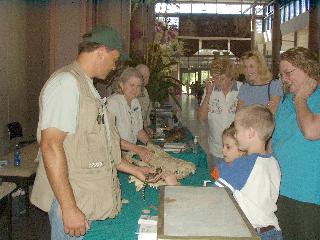 -
-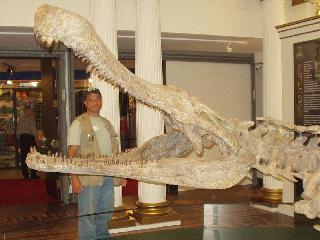 -
-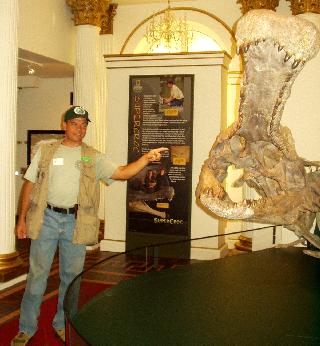 -
-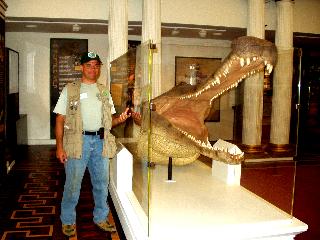
THE SPARK IN THEIR EYES I'M IMPRESSED 4 OUT OF 5 DENTISTS FIT DO NOT OVERFEED
This
page deals with fossil crocodilians, and also will include some
descriptions
of what makes a crocodile different from an alligator. After all, when
one is dealing with
fossils, it is possible to be looking at remote ancestors
of what is living now. Sometimes taking a close look at the remains can
give hints of how our current animals
came to be.
THIS
PAGE CAME INTO BEING BECAUSE OF THE EVENTS STARTED ON JUNE 7TH, 2003,
AS
SHOWN ON THIS PAGE. ALTHOUGH THE SARCOSUCHUS WAS NOT
(AT THIS TIME)
SHOWN TO HAVE LIVED
NEAR TEXAS, OR EVEN ON WHAT BECAME THE NORTH AMERICAN
CONTINENT, THE DEINOSUCHUS DID. THAT IS, NOT ONLY
DID IT (OR A COUPLE
DIFFERENT TYPES) LIVE ON THE NORTH AMERICAN
CONTINENT IN THE PAST, BUT
ITS REMAINS HAVE BEEN DISCOVERED IN TEXAS (ALTHOUGH QUITE A DISTANCE
FROM
THE CURRENT GULF COAST AREA). SO, I STARTED THIS PAGE AS A PLACE TO
PUT
INFORMATION I MIGHT FIND ABOUT THEM. SINCE IT IS ABOUT
RELATIVES
OF THE ALLIGATORS (SOMEWHAT DISTANT, BUT RELATIVES NONETHELESS), I'M
PUTTING
THEM IN THIS SERIES OF
PAGES IN MY DOMAIN.
June
07, 2003This
weekend marked the opening of an exhibit in the Houston Museum of
Natural
Science. That exhibit shows the media-exposed fossil reptile known as
"Super-Croc",
or Sarcosuchus. . I find it interesting that there is another fossil
crocodilians--remnants
of which were found in the U.S.; which has been estimated to be about
the
same size (if not larger)
while living than Sarcosuchus--known as Deinosuchus
(sometimes Phobosuchus). For some reason that one isn't receiving the
same
media attention, though. But, I digress.
Frequent
visitors to these pages will be surprised (yeah, right) to learn that I
wanted to see this exhibit. On Saturday, a group of us from Brazos Bend
State Park had an "outreach" table
set up at the museum (see SPARK, below).
During the day we showed examples of some living reptiles, and talked
about
nature in general (over 2,000 visitors to our table!!! YOW!). That
was
cool enough...but we *also* got to go see the Sarcosuchus! Is it big?
Yep.
The RICKUBISCAM, as well as the pictures below, with me in there for
scale,
should give some size
comparison. The last picture (ALLIGATOR VS.
CROC, below) shows my hand holding a tooth from a large alligator
(perhaps
about 11 feet long) that had died at the park some time ago.
I don't know
*which* tooth it is, but it's pretty big. I usually have it in one of
my
pockets (Don't tell me this is a surprise.). I was able to lean over
into
the display and snap this picture. That's
an impressive difference.
 -
- -
- -
-
THE
SPARK IN THEIR EYES
I'M
IMPRESSED
4 OUT OF 5 DENTISTS FIT
DO NOT OVERFEED
As
time
and resources allow, I'll try to find out more about the Deinosuchus.
Among
other things, this is perhaps an illustration on how "popular" science
might work. If you have the resources to pay for it, you can go to the
media and make a discovery well-known. The
traditional method--submitting
findings for review by experts before going public--is the scholarly,
scientific
procedure. This takes time, however, and isn't very profitable. Going
public
with a more
sensational discovery can generate media attention and reap
financial benefits. It also allows one to make their
opinions well-known
and have their name attached to a significant finding. Is this
a bad thing?
While not giving a clear demonstration of how science should
work--it does
have the benefit of getting people interested. It gets them
thinking...gets
them into the museum. If, in the
course of a TV special, full
credit isn't given to others in the field, or some erroneous
information
is divulged--if most
of the information is good; then it goes into those
minds that were opened
by the "sensational" aspects.
That
seems ok to me, also. After all--I
wouldn't have started looking
for information on Deinosuchus if I hadn't gone and
done this.
Also, generating lots of interest in crocodilians while
presenting them
in a positive light is something I support.
Ha
ha
ha...but I guess people who visit here would know that.
Update
Monday evening: I've found three places on the internet with some
information
on these large creatures. I can't believe I missed this. What was I
thinking?
I've found the book on Deinosuchus by Dr. Schwimmer. Hopefully it will
be on its way to me soon. If anyone
has any suggestions
on how I could get a casting or
mold or replica of a Deinosuchus
tooth--that
isn't too expensive--for the park , please email me
(rickubis@takethisoutyahoo.com).
What an interpretive tool this could be!
Alligators are one
of our
most popular attractions. Imagine being able to show a Deinosuchus
tooth
(or skull...hey, I can dream can't I?) and say that THESE
crocodilians
were hunting in the same area during the late Cretaceous that
alligators
live in now. Here are the links (I
dislike linking to other
pages for a number
of reasons, but this is one of those few times I
think
it's necessary.): Picture
of the jaws with information.
Newspaper article.
June
14, 2003After
last week, and the viewing of the Sarcosuchus, I had to find out more
about
the Deinosuchus, the giant fossil crocodile that was found in the U.S..
I found out that the skull
of a Deinosuchus was on display at the
Dallas
Museum of Natural History. So, I went to go see it. The images below
(RICK
AND DEINOSUCHUS. RICK AND SARCOSUCHUS) show me
standing next
to two
large ancient crocodilians. Cool? I think so.
-------------------------------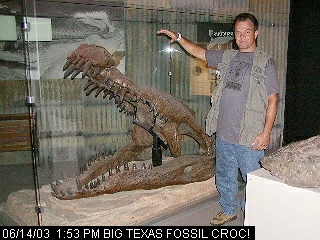 --------------------
--------------------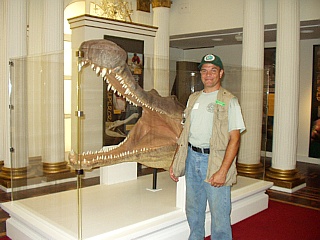
RICK AND DEINOSUCHUS
RICK AND SARCOSUCHUS
Since
then, I've found out some interesting things about the Deinosuchus in
general
(I've only just gotten this book) and the skull in Dallas. The
information
I mention here comes from the book:
King of the Crocodilians-The
Paleobiology
of Deinosuchus, by David R. Schwimmer ©2002 .
First,
the skull on display was originally shown at the American Museum of
Natural
History, in New York. This display was was made from fossils excavated
from Big Bend National Park in
Texas, in 1940. Unfortunately,
only
fragments of the skull were found, and so the largest part of the skull
was modeled in plaster by extrapolating from recent crocodile species,
most probably
the saltwater crocodile (Crocodylus porosus).
However,
later Deinosuchus finds have shown that the proportions of the
reconstructed
skull are not correct. Among discrepancies that have been
found are:
the profile of the upper jaw, which
is curved upwards more than it
should
be; and the angle of the snout from the front to the
back(viewed
from the top). The skull has been reconstructed at too narrow an angle,
similar to a
crocodile's; while the Deinosuchus skull is actually
broader--more
like an alligator's. As a side note, the Deinosuchus skull also
features
most of the teeth in the upper jaw extending over the
lower--covering
the
teeth in the lower jaw(also similar to an alligator's), with
the
exception of the fourth tooth on each side. These two bottom teeth were
exposed while the mouth was closed.
The teeth on the reconstructed
skull
featured in Dallas are also probably spaced too far apart. The
reconstruction
as it stands still does show an approximate size,
though.
I
hope
that someday a more precise reconstruction can be made of the giant
found
in Texas. Fossils of this late Cretaceous reptile have been found in
Alabama,
Georgia, Mississippi,
Montana, New Jersey, North Carolina, Texas, and
Wyoming.
The fossils seem to show (as far as I've read, at this point) that
Deinosuchus
was a successful predator that lived along the
edges of the inland
shallow
seas and brackish swamplands of the time. Through most of its range,
and
in its habitat, it was probably the pinnacle predator, successfully
competing
with, and
even hunting, the large therapods (carnivorous bipedal
dinosaurs)
of the time. As I find more information (that is when I read more of
the
book), I'll put more information here. I won't be
duplicating any of
the
pictures from the book here, so if you want more information, find the
book.
I
just
can't get over this huge reptile that could have been living right
where
I am now, and it probably hunted where I can see living
alligators!
Oh...one other thing. The Deinosuchus, while
called an "alligatoroid
type"
in the book, is probably not a direct ancestor of the alligator, but
probably
on a branch of the family tree that branched off after the common
ancestors
of all
crocodylians but split off again before alligators, and before
crocodiles.
(It's a bit confusing for me, but the term "crocodilians" seems to
include
living animals in this group, while
"crocodylians" includes all, living
and ancient, which share the same traits.
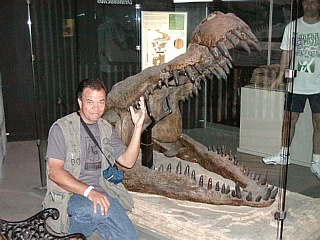 -
-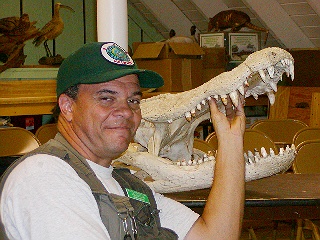 -
-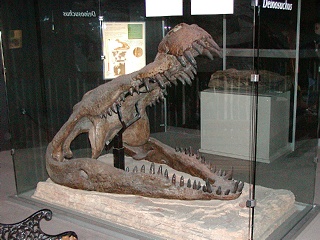 -
-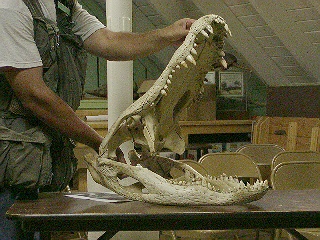 -
-
I'M A MORSEL!
I CAN HANDLE THIS ONE
DEINOSUCHUS SKULL
13 OR 14
FOOT
ALLIGATOR
Here
are more pictures. Here I am again, in front of the skull. (see I'M A
MORSEL,
above). For comparison, I photographed myself with the skull
of an
alligator that had died in the park
(see I CAN HANDLE, above). The
estimated
size of the living animal was 12-14 feet long. There's another picture
of the skull, without me (see SKULL, above), and then the same
alligator,
which I tried to stage in a similar position for further comparison
(see
ALLIGATOR, above). And finally, my alligator tooth (from an 11-12
footer)
compared to the Deinosuchus in the case
(see ALLIGATOR vs.
DEINOSUCHUS,
above.).
November
6, 2004I
helped with a BBSP outreach at the Houston Museum of Natural Science
today.
We had about 2400 people (yes, two thousand four hundred) come by our
table.
In many
events of this type, we have a "clicker" that we use to keep an
informal count of people who stop by. We had about 200 stop by just
between
9:30 and 11:00-and we didn't "officially" open
until 11. There were 6
of
us at the table. Early on, I mentioned casually that Dr. Robert Bakker
was at the museum, and maybe I'd get a chance to see him, and possibly
meet him. Through the
day, I got occasional ribbing about it.
Then,
he wandered by, carrying the foreleg of an Allosaurus, and he wandered
over to our table. When he did, I walked over and asked if he was
Robert
Bakker. When he answered yes, I asked if I could shake his hand and
said
it was good to meet him. Then we had a short conversation about our
crocodile
skull, and I'm sure I sounded
like part of my brain was missing.
Afterwards,
Chuck came over and stage-whispered, "You get your
chance to meet your hero, and you ARGUE with him? HA HA HA !"
"Great...THANKS!
Shut up."
Later,
I was bemoaning the fact that I didn't take any pictures, and neither
had
anyone else. I got ribbed about that, too.
"Ask
him to come back over, he won't mind."
"No.
YOU ask him."
I
just
didn't want to bother Dr. Bakker.
Later
on (the day went fast), Sandy told me she'd asked Dr. Bakker to come by
our table.
Sometime later, I was holding one of our snakes and talking to visitors about
it when David came over and said, "You'd better give me that and go
talk
to your guest.".
And
there was Dr. Bakker. I gave Rich my camera, gave him hurried
instructions
on its use, and Chuck got his camera.
And
I walked over to Dr. Bakker and suppose acted a bit like a goof.
Fortunately,
I unfroze and actually uttered words.
Then
Dr. Bakker handed me his Allosaurus claw and said "You should hold
this."
So I did (and that's I'M SPEECHLESS, below), and then we started
looking
at skulls and then talked to a few
visitors to our table. He started
looking
at our skulls, and we discussed a few things and then we talked to more
visitors. There was a little interchange between Sandy and Dr. Bakker.
And then
while I was talking to some people, Dr. Bakker wandered off.
And
that was it. Later, I found out that Chuck had also asked Dr. Bakker to
come by our table.
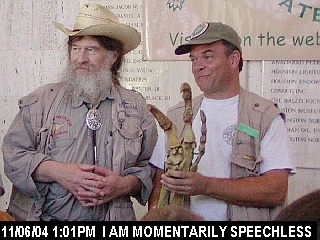 -
-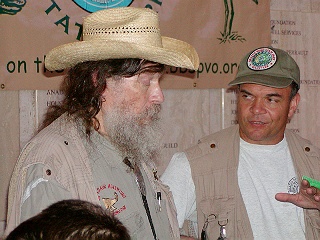 -
-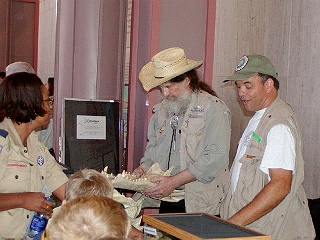
I'M
SPEECHLESS!
ALLIGATOR
VOCALIZING?
EXAMINING THE REAR SINUSES
Dr.
Robert Bakker is one of the most well-known paleontologists in the
world.
From youth, he has been captivated by dinosaurs and other ancient
creatures,
and he pursued this interest until he's
become a noted authority. He's
written 2 books that I've read; The Dinosaur Heresies, and Raptor Red.
I read them some years ago, when they were published.
I
admire
anyone who has followed their interest and has become a scientist. I
admire
Dr. Bakker more because he pursued his interest in
dinosaurs (which
I still find interesting). These
achievements deserve respect. What I
find
awe-inspiring
is how he can share his interest and his knowledge with almost anyone.
Having the knowledge is a gift (one he worked hard for). Wanting
to
share
that knowledge is another gift. Being *able* to share that knowledge is
yet another gift (not everyone who is knowledgeable is a capable
teacher).
Sharing that knowledge in a way that will
cause another's interest to
brighten
is perhaps the greatest gift. Dr. Bakker has all of
these, and this
is why I was glad to meet him, and shake his hand.
It
is
because of people like Dr. Bakker that I make the effort to keep these
web pages. He has inspired me, and if I can inspire
any of the visitors
to my pages to look at the world around them
differently; or to
investigate
it further, then I'll be happy with that.
The
other
two pictures are self-explanatory. If I look happy in the pictures,
it's
because I am. Thank you, Dr. Bakker, for coming by and saying hello.
Thank
you to Sandy and Chuck for helping it
happen, and thanks to Rich for
taking
the pictures that are shown here.
----------------------------------------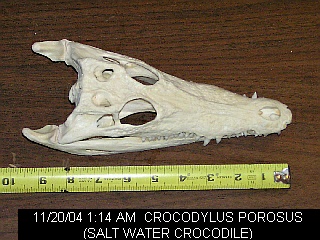 --------
--------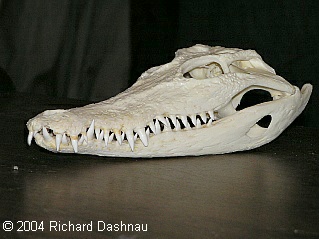
C.
POROSUS TOP VIEW
C. POROSUS OBLIQUE VIEW
The
supplier avers that this skull came from a crocodile culled from one of
8 Australian crocodile farms, and the bill of sale states
this. This
skull, when measured from the tip of the snout to the base
of the skull
(I believe there should be a little bump there, the occipital, that's
missing)
would be about 8 1/2 inches long.
There
are two mathematical formulas on page 47 of the book: King of the
Crocodylians-The
Paleobiology of Deinosuchus, by David R. Shwimmer. The first is
TBL=-4.39
+ 7.47THL. This indicates
a relationship between the Total Head Length
(THL)-measured as I indicate above-and the Total Body Length (TBL) for
a Crocodylus Porosus. This formula was derived from a sample of
specimens
ranging from 2 to 16 feet long. According to the formula, the crocodile
that my skull belonged to was about 5 feet long. This is
probably
relatively young (in our alligators at Brazos Bend State Park, a
5 foot
alligator would be about 5 years old, and not yet mature.), and the
skull
would probably become heavier as the crocodile grew (just as older
alligators
have generally broader and heavier heads
in proportion to their
bodies).
Still, the broad ridge (and no central hump) running down the top of
the
snout is clearly visible. On older animals, the edges of this evidently
become separate ridges.
See (POROSUS/ACUTUS PROFILE VIEWS;
POROSUS/ACUTUS
PALATE VIEWS, and C. POROSUS OBLIQUE VIEW above).
These
four identification links can be checked to verify this.; two pages on
the CITES (CITES= Convention on International Trade in Endangered
Species
of Wild Fauna and Flora) crocodilian
identification pages. This link is
for the c.
porosus , and this link is for the c.
acutus . More identification features can be found
on www.crocodilian.com;
here
for c. acutus; and here
for c. porosus.
If you'd like to know more about the park follow these links:
Brazos Bend State Park The main page.
Brazos
Bend State Park Volunteer's Page The
volunteer's main page.
Here are a few links to more information on alligators. There's a LOT of it out there.
Fish and Wildlife Endangered Species
Go back to my main alligator page, Alligators
Go back to my home page, Welcome
to rickubis.com
Go
back to the RICKUBISCAM
page.
Go
back to the See
the World page.